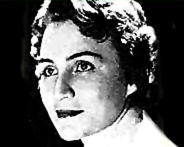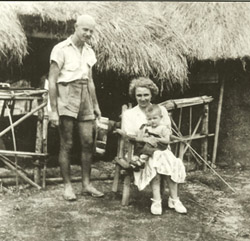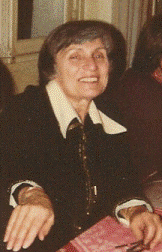
|
|
|
|
|
|
|
|
||||||||
Anne Golon: The portrait of a French writer
The fate of Anne and Serge Golon was not perfect in every moment, yet they have always loved the beauty and believed in the success. The paths of two distinctly different and remarkable people, an attractive French woman and a charming aristocrat, had crossed somewhere in Africa. However in that time, they both had been through a number of different adventures...
As a child, she was often ill and the days spent at home instead at school (she supposed that she would hate the school anyway) she was spending with drawing and writing. In these activities she met best circumstances for her creativity development and way how to spend her energy. She wrote her first book almost as soon as she learnt to write and she finished her first book “Au Pays de Derrière mes Yeux” as 18 years old (published in 1944, Desclée de Brouwer). Simone Changeux under pseudonyms Anne Servoz, Dominique Ponmain, Joëlle Danterne and Anne GolonThe war was not able to make her silent. Although the France was under German occupation, she was publishing a lot of articles and books. Moreover, she found a way how to get from the Nazi oppression and to travel to French countryside. She got the official agreement and one day left Paris full of German solders: Her journey on bicycle continued from Versailles through Poitou till La Rochelle. Every day she went some new kilometres, was writting, drawing pictures of countryside, and every night she asked for a bed in some convent. She asked for legal cross of the Spain border, nevertheless she was arrested on the border by Nazi Gestapo. Later, she was remembering her escape as a small miracle.
She came back home full of energy and started to write again. Her first books comprise: Le Cailou d´Or (Editions de Flore), La Patrouille des Saints Innocents, Le Chasseur aux Yeux Clos, Alerte au Tchad, Master Kouki (Editions Alsatia). The young journalist, novelist and author of a screenplay La Femme en rouge, also founded the magazine France 47 (later renamed “France Magazine”). Her life got a direction – a meeting with mysterious researcher and artist Vsevolod GoloubinoffAfter the war, in 1947, Anne was honoured with the literal price “Guy de la Rigaudie“ for her work La Patrouille des Saints Innocents. Then she was sure that her writings can pay for a living, she decided to leave the country where she had to lead battles for every single article. She wanted to go as far as possible. Because she didn’t speak English, she chose for equator Africa. It was just a coincidence: Her colleague asked her for a portrait of some geologist and chemist, whose work was discovering of gold mines in Africa. She was ready to write about people and African countries, but only 2 weeks after her arrival to Kongo everything changed a meeting with doctor Vsevolod Goloubinoff – later known as Serge Golon.Vsevolod Sergeïvich Goloubinoff was born on August 23, 1903 on the Persia territory (Boukhara, Turkestan), where his father Sergeï Petrovitch Goloubinoff served as am ambassador of Russian tsar. The family household enjoyed many servants and one says that only the ambassador used 20 servants for his own needs. The noble family wasn’t happy that young Vsevolod was spending more time with horse riding and hunting than studying. Nevertheless, his personality showed to be perfect for the next life circumstances. “Serge Golon was something as Marco Polo, Michel Strogoff, Tintin, Profesor Tournesol and M. Hulot together." (Goloubinoff, N. Preface in Golon, A., L'Intégrale, p. 9-16, 2006). The quarter century he spent as an adventurous scientist under various skies of the world. As a geologist and chemist, he was discovering where the ore deposits in the Indochina, Chine, Tibet… and in Africa, where the destinies of 46 years old Serge and 28 years old Anne met.
When there started a revolution in Russia (1917), the Goloubinoff family escaped to France through Constantinople and desert. Vsevolod studied in Sevastopol at the time, and he escaped from the revolution horror only with one gun under a beggar’s clothing and a little of gold in his shoes. Later he contacted his family. Nevertheless, they became from rich aristocrats just the poor refugees. He spoke French as most Russian noblemen, and was gifted for languages in general. Sunrises in AfricaThe young doctor of natural sciences left for Africa and supported his family and his younger brothers and sisters during their studies. In the services of a “Free France” movement, he was authorised by general de Gaulle to find diamond and gold mines which could help to his people in England and in the free France after the war. The government in Vichy convicted him in absentia, but thanks to the colonial grace and general Leclerc, he was able to leave Africa in the end.He came back to France 8 years later and his friend asked him to write a book in cooperation with another more experiences author. Thus, the first Vsevolod’s memoirs got a literal form from other author and Vsevolod himself used for the first time pseudonym Serge Golon for publishing the book Le Cadeu de Riza Khan. The work won a price “Prix du Corsaire”. The book with an original adventurous plot got popularity, nevertheless the author (Serge) got only the literal price and the more experienced co-author got the author rights. It was in year 1947 when a young journalist under pseudonym Joëlle Danterne just got a price “Guy de la Rigaudie”.
Africa brought wonderful nights in a wild nature, caravans, friendships between indigenous tribes, scarified woods, but also treats, indigenous sorcerers’ curses, robbing of houses, crimes of powerful industrialists… In the end the couple left the black continent and returned back to France. Their cooperation on writing was nothing else than a coincidence. Serge was not able to find an appropriate job and was spending many years searching for a job in his field. Unemployed and with debts, he gave up and young couple settled in small room leased in house of Anne’s mother. Anne continued in her writing as she always did. She listened to her husband adventures and published series of articles about. A book about Serge’s childhood followed and presented a story about Serge’s meeting with German spy and scientist who inspired him for this profession. She also helped him with the form of his own memoires Le Coeur des Bêtes Sauvages and together they created Les Géants du Lac. Because the books were presenting his memories, they decided to publish them under his pseudonym. Except of this, Anne published 3 other books about Africa (Alerte au Tchad). It was good beginning and practice for their future cooperation and creation of unforgettable hero: Angélique. Living textbook of historyOne day, in Versailles, 1952, Anne Golon was turning with a pen between her fingers as many times before, but this time her memories of Poitou crossed her mind. She remembered a picture of her riding a bicycle, she saw again the countryside, convents, the old ash trees bent over green swaps, large yellow flowers in bloom and a little blond girl running around. Angélique, marquise of Angels was created in Anne Golon’s head same as all characters of her stories before. No revelation in Lourdes, just usual good idea of a good author. In the moment she was sure that this young blond girl will be the hero of her new work, she will live under the reign of Louis XIV. And one day she will leave for New World… “Angélique, as a wild yellow flower from swaps, so called flower of angels (l’herbe des anges), as a first name, very popular in the 17th century…, as a touch of wings form heaven” (Goloubinoff, N. Preface in Golon, A., L'Intégrale, p. 9-16, 2006). |
Under the pseudonyms Anne and Serge Golon, they started to work on a historical novel. They opted for the Sun King’s epoque, because they were living in the oldest part of Versailles, it means just opposite to the library and few steps from the palace. Anne always loved history and from time to time she considered to write a historical novel. Moreover, there didn’t exist any serious work about the Sun King’s age in a modern history of her time.
So one day Anne and Serge crossed the road and stepped into the library and started with research of everything that was being written on 17th century. They were discovering real treasuries in historical documents: Serge found a very old book about poor noblemen and Anne decided to set family de Sancé to the old chateau in quite bad conditions. They also discovered an old book about conflict of Langue d’Oc (the south of medieval France) and Langue d‘Oïl (the north of medieval France) and voilà, Anne created the character of count de Peyrac, big Occitan sovereign. On the quay of Seine in the city, they found a book about Berbers and slave market in the Mediterranean and Anne knew that one day Angélique will get right there. Here started the work. At the time, they created Angélique with her strong character able to face the world. More than a year Anne and Serge worked in the library, searched for details from 17th century, they read hundreds of books and documents and in the same time they wrote a lot of notes and plots. Anne used to spend all days in the library and Serge was helping her. In the time he still looked for a job in his field in Paris and during the nights they wrote a lot of parts of the story. Until they took over the historical context, they were ready to create the fictional plots. The first large book Angélique, marquise of the Angels had got more than 900 pages and later had been published in 2 and even more parts, because Anne extended it later: Angélique Marquise des Anges, Mariage Toulousain, Fêtes Royales, Le Suplicié de Notre Dame. Requirements of publishers, stories of journalistsSerge Golon enjoyed looking for proper utilization of their works. One day in Paris he met agents from a not typical agency (Opera Mundi was about starting in France, they represented Walt Disney company and published magazine Mickey). Serge proposed them his wife’s manuscript and this international agency saw a good potential in this work. Unfortunately, the agency also started a lot of confusing stories about the work, e.g. that each of them wrote 50% of texts and that they are just salesman more than authors and prepared the book on the order.The first book was published in 1956 in Germany under the name Anne Golon. One year later there were published two books in France: Marquise des Anges I - Angélique and Marquise des Anges II - Le Chemin de Versailles under the names Anne and Serge Golon. The agency supposed that book published under the male name is more serious and Anne would happily agree, but Serge appealed at least for a compromise: 2 names. From the reason of easier recognition in English speaking world, the agency decided for a name Sergeanne Golon on the book covers in English speaking countries. From the beginning, the book became a bestseller just everywhere. Angélique was translated in more than 20 languages. In the English editions were no information about authors thus readers had no idea if Sergeanne Golon is one or two authors or if he/her is a living author. A family life in Switzerland
"In my very first memories, my brothers, sister and I, we watched our mother everyday writing Angélique and our father (after his last return from Africa in 1961) painting and continuing his researches” (Goloubinoff, N. Preface in Golon, A., L'Intégrale, p. 9-16, 2006). Nadia remembers not only magical atmosphere of their childhood, but also contemptuous laughter of journalists who asked their father about Angélique and how he answered with his calm face “you need to ask my wife, she is the author.” They assumed that he was just a weak husband who let her wife to enjoy a popularity. In France of the time, married women had only very small rights. Nevertheless, in 1960s Anne Golon and her husband were experiencing huge popularity with their books which can be compared with e.g. J.K. Rowling’s Harry Potter series in 2000s. Present and future
At the time there began to appear the first articles about Serge as the only author of Angélique, who just died. This is how the publishers made Anne Golon dead for her readers. She continued in writing her life work, but she didn’t get any more money for. The agency had stolen her author rights and stopped paying her despite of the success of the series around the world. For example, in Russia 1991 were officially sold 15.800,000 books (and in the next year there was a new edition) and Anne Golon didn’t know and got nothing. She was told that there is no more interest in her books. The most of illegal books were published in Russia, but e.g. in the Czechoslovakia we can find simple book 6x Angelika (Princ, 1991) which used the original characters and plots from Anne’s series in a changed story. Moreover, there appeared fictive ancestors of Serge Golon under the names Alex Golon, Xenia Gabrieli, Anne-Marie Nouvo and they all profited on the very popular Angélique series. The readers were told again and again that the author of Angélique series is dead (some articles even described Angélique’s author as the Alexander Dumas’s contemporary). For the next 30 years Anne Golon continued writing with no much believe that she would finish her life work. In the end of 1990s thanks Internet possibilities, Angélique fans from around the world discovered their favourite author and wondered that she is still alive. Madame Golon at the time lived back in Versailles in poverty together with her daughter Nadia who decided to lead a battle for their author rights. Anne Golon found out that almost all editions of Angélique were changed by publishers and she started to rework her life work from the first book again and in the meantime she continued on her research for the last book. In 1995 she got officially her author rights back. The court decided for her and the large publishing house had to pay her the damages. Nevertheless, the publishing house filled an appeal for a new litigation hoping that the 80 years old lady will be not much longer real (living) problem. With all the juristic procedures the litigation lasted till December 2004 when Anne Golon really won.
In the end of the year 2004 Anne Golon got at a least a real appreciation for her life work in her home country – France: It was on the 14th December 2010, when French minister of culture Frédéric Mitterand honoured Anne Golon for her contribution to French art and literature with an order of art and literature (l'ordre des Arts et des Lettres). Anne Golon died on 14th July 2017 at home in Versailles and her funeral took place in the local cathedral of Saint Louis few days after. Although she worked on her series till the end, her life work Angélique has been never finished. Used literature: Goloubinoff, Nadine. Preface in Golon, Anne: Angélique L'Intégrale: Angélique, Marquise des Anges. Lausanne: Éditions du Refuge, 2006. ISBN: 2-9700527-0-9; 9 782970 052708. Krátká, J. Michèle Mercier/Anne Golon. Blokbaster, 1, 2004, Nr. 8, p. 66 – 69. ISSN 1336-4480. Princ, Karel. 6x Angelika v jediné knize. Prague: Cesty, 1991. ISBN 80-85363-12-7. Les Éditions du refuge The World of Angélique Monteloup: Anne and Serge Golon |







